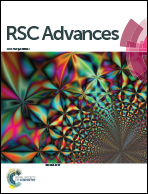Unique self-assembly behavior of amphiphilic block copolymers at liquid/liquid interfaces
Abstract
Diblock copolymers (polystyrene-b-poly(2-vinylpyridine) (PS-b-P2VP)) with different molecular weights self-assembled into various supramolecular microstructures at the polymer chloroform solution/aqueous chloroauric acid interface under different conditions. Generally, multilayered foam films composed of microcapsules with walls decorated with or without round interfacial micelles formed when using a higher concentration of aqueous solution; honeycomb monolayers appeared with decreasing aqueous solution concentration; fish net-like or labyrinthine monolayers were generated with a further decrease in aqueous concentration. The appearance of these microstructures reflects the different adsorption and self-assembling behaviors of PS-b-P2VP including interfacial micellization, encapsulation, and microphase separation under different conditions. In addition, the relative molecular weights of the two blocks and the total molecular weight of the polymers had a large effect on the adsorption and self-assembly of the polymers and on the final microstructure architecture. Furthermore, the factors that affect the adsorption rate and intermolecular interactions of the polymers and, consequentially, the self-assembling behavior and final microstructure are discussed. The catalytic activities of these composite microstructures were evaluated.


 Please wait while we load your content...
Please wait while we load your content...